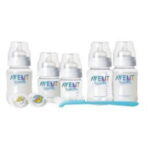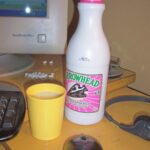I know from experience that choosing a breast pump is a little intimidating. Selecting a breast pump is not a trivial matter, if you will need to rely heavily on a breast pump for milk expression, the right pump could make the difference between breast feeding success or failure. Breast pumps vary widely in style, appearance and price (anywhere from $30 to $200). Here is my personal review of both the Avent and The First Years breast pumps.
Avent
The Avent breast pump that I purchased when I had my first baby was a single, manual pump. The first thing I found that I liked about this pump was that it didn’t appear intimidating. It was easy to assemble as well as disassemble and I was instantly comfortable with using it. While it took a few tries to regulate the amount of pressure I used to encourage milk let-down, I quickly adapted and was able to use the pump at full strength comfortably. My body responded well to the pump’s mechanism for encouraging let-down, which would usually occur within about five minutes. This pump also gave me great flexibility. Since it was so small, I could fit it in the diaper bag or even a bottle cooler. I could use it in the car or in my office at work. It was also possible to use this pump on one side while I breast fed on the other; this makes pumping much quicker and also encourages greater milk production. I got my Avent pump on sale for $45.
The only problem I encountered with the Avent pump was a plastic cover that broke after several months of use, and only after I dropped it. However, when I contacted customer service, they volunteered to replace the part for free, and shipped it to me immediately along with a few extra new pieces. The basic model of the pump also includes two bottles, nipples and covers.
The First Years
The First Years breast pump is a bottom-of-the-line double electric breast pump. It comes with many extras, including bottles, nipples and and milk storage bags and retails for about $40 at Walmart. The pump includes a black carrying case. While I liked the idea of having a double electric breast pump, I was disappointed in this model. While some women may respond well to the motor and let-down mechanism on this pump, I did not. It usually took about 10 minutes to stimulate let-down and sometimes it didn’t work at all. I found the use of this pump to be stressful, as I was always watching the clock, wondering how long the pumping session would take. The motor on this pump is also quite loud. There is a pumping sound along with a continuous humming sound. If you are trying to pump quietly in the evening or early morning hours, this pump could easily wake up your baby, or at least your spouse. The pump does provide a dial for you to adjust the strength of the suction. For tender nipples, even the lowest setting may be uncomfortable, and the highest setting, completely unbearable. The pump also sports a single handle located in the center of the pump. Though this is supposed to be an advantage, I found it difficult to maintain good pump positioning on both breasts using only one handle. I frequently needed to switch hands and make adjustments.
The one thing I truly appreciated about this pump was the milk storage bags. Besides that virtue, I found very little to be admired. .
Selecting a breast pump is a difficult and even stressful venture. Be sure to do your homework by reading reviews and especially by talking with women you know. If you plan to do only moderate to light pumping, I highly recommend purchasing an Avent pump. If you will need to use a pump frequently, bypass The First Years pump in favor of a higher end model.





